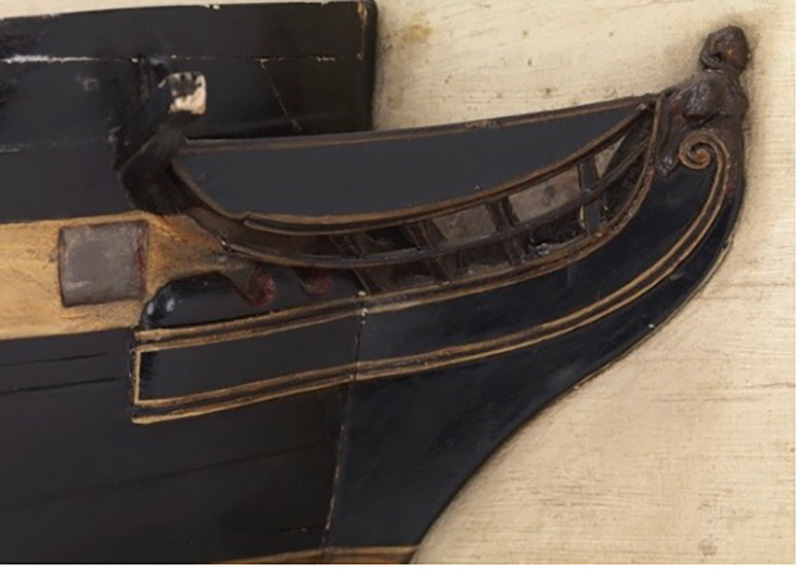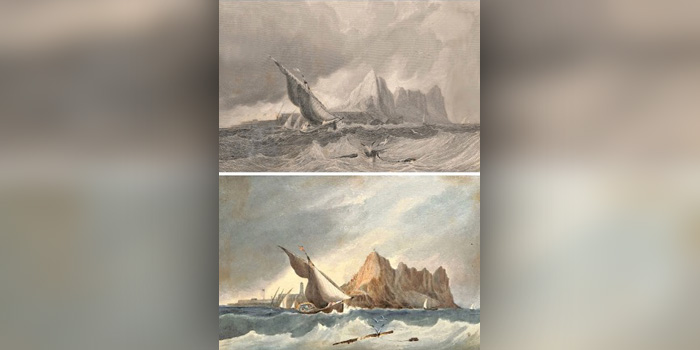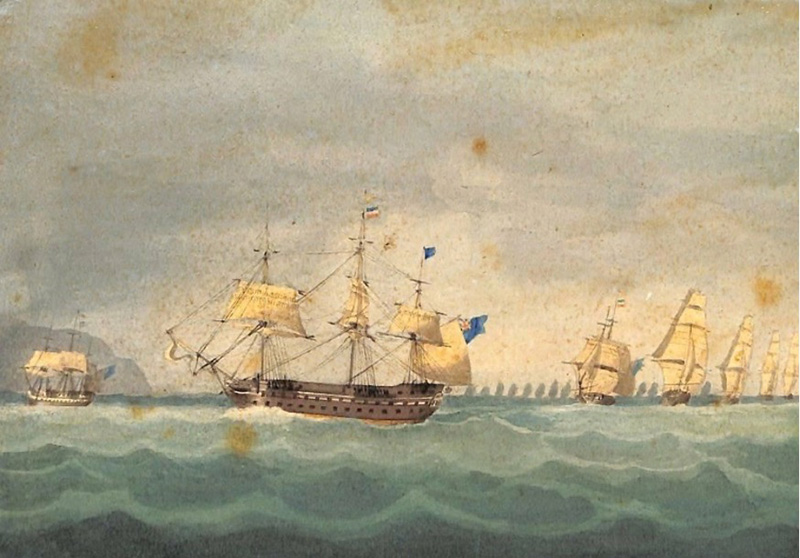Column: Bermuda’s Royal Naval Tanks, Part 3
[Column written by Dr Edward Harris]
In the first part of this series on the Royal Naval Tanks at St. George’s Island, Bermuda, the earliest [1803] published image of the watering facility for British warships was presented and then discussed in Part 2. In Part 3, the identities of the warships in the 1803 picture are considered and the 1808 and circa 1815 copies of the 1803 image are introduced.
Identification of the Ships of the Line
The identity of the two warships in the Porgay image remains in question, but in Bermuda on 15 January 1803 were “in harbour his Majesty’s frigates HMS Leander and Cambrian, and the Pheasant sloop of war”. On the 18th, the ships fired a salute, following a feu de joie for the “Queen’s birth”, and on Thursday, 20th, HMS Boston, another frigate, arrived from Hampton Roads, Virginia. At the end of January 1803, the Bermuda Gazette reported that those were the four Royal Navy ships in Bermuda, the Leander being the flagship of Vice Admiral Sir Andrew Mitchell, KB.
Excluding Pheasant, the smallest of the vessels, it is likely that the ships in the 1803 picture are Leander and Cambrian, but Boston is also a candidate, although the smallest at 32 guns, versus 50 and 40. It could be that the picture was meant to reflect the entrance of the Flagship, Leander, into Bermuda waters, but the question is yet to be answered.
Also in January 1803, the Bermuda Gazette reported that the crews of the ships were all well, whereas those at Jamaica had been devastated with illness, perhaps Yellow Fever. Admiral Mitchell sadly died in Bermuda three years later, having been married at Halifax the year before in 1805.
Fig. 12. A sepia watercolour copy of Porgay’s view, dated to post-1808 by the watermark of the paper. [Keith Adams Collection, Delaware.]
The Post-1808 Copy of the Porgay Aquatint
In late 2023, a sepia watercolour that mostly mirrored the 1803 Porgay image was purchased by my colleague in heritage and collector of Bermudiana, Keith Adams, and is published here. On the reverse of the image appears in ink script “Murrays Anchorage, and Watering Tank. Bermuda”, with initials transcribed as “RBR”, as yet unidentified. On closer observation, the watermark of the paper is “H. WILLMOTT 1808”, dating the image on the obverse to sometime that year, or at least five years after the publication of the Porgay original. While clearly a copy, the “Willmott” sketch of post-1808 has some significant differences.
One of the major changes is to the ship at anchor, where the rigging is different and appears in more detail. The ensign on the stern has been deleted and two dinghies have been added, one approaching the stern of the vessel and the other moored to a boom extended from the port side. The nearby mooring buoy has also been eclipsed. Other details are relatively consistent with the original, except that on land the water tank building is reduced in size and the line of the rope and buckets has disappeared, perhaps because the artist did not know what was being so represented.
A final, perhaps whimsical, note is that there is the slightest hint of a figurehead on the warship under sail entering Murray’s Anchorage. That may suggest that the vessel was HMS Cambrian, rather than the flagship in 1803, the Leander, as below per the photograph of a model of the ship at the National Maritime Museum, Greenwich. Thus the unknown artist of the post-1808 watercolour may have known which vessels the ships were.
Fig. 13. A detailed view of the bow of a model of HMS Cambrian with its figurehead and splayed lines on the hull. [Royal Museums Greenwich.]
Before moving to the second iteration of the 1803 image, a word on the papermaker, “H. Willmott”, may be of interest. The Willmotts were papermakers on the River Darent in Shoreham in the northwest of Kent, only ceasing operations in 1921 after three hundred years. The probable “H”, Henry Wilmott, born 1782, was a son of Thomas Wilmott [1749–1812] and would have been 26 at the time of the manufacture of the paper.
There is some confusion with the surname, as modern references cite only one “L”, but Thomas’ 1813 will, to the contrary, is recorded as Willmott, with two Ls, as reflected in the watermark of 1808. A second copy of the Porgay aquatint, another watercolour as below, appears to have been made around 1815.
Fig. 14. “The Tonnant of 80 Guns going into Burmuda [sic] with a View of the watering Tank” [As described on the page of the album on which the painting is glued. Private Collection.]
Henry Bonham Bax’s Watercolour Copy
Henry Bonham Bax was born in 1798 and died at the age of 71 in 1869, then an Elder Brother of Trinity House, London [from 1844]. He entered the Royal Navy as a midshipman in 1813 but spent only four years in that service, later becoming a Captain of the Honourable East India Company. A grandson, Robert Nesham Bax, CB, followed in his first footsteps afloat but went on to become an admiral in the Royal Navy. Henry’s mother was Jane Bonham and his wife [m. 1829] Anne Hanson; the two female surnames were carried down into the following generations as middle names.
According to Neville Chipulina’s blog, “The People of Gibraltar”, Bax served some of his four years in the Royal Navy on HMS Mulgrave, a 74-gun third rate, launched in 1812 and broken up in 1854. An album entitled “Sketches of the Proceedings of His Majesty’s Ship Mulgrave of 74 Guns”, by Midshipman Henry Bonham Bax, 1813–1817, was loaned by descendants to the Royal Museums Greenwich.
The ship saw service with the Channel Fleet and was later in the Mediterranean, where it engaged with the naval forces of France. There is some suggestion that Bax was in the American and Caribbean theatre after he was released from French captivity in 1814, perhaps arriving in these waters in the summer of that year. His naming of HMS Tonnant as being the vessel entering Murray’s Anchorage is perhaps evidence of his serving on that ship of the line for a period between the summer of 1814 and his resignation from the Royal Navy in 1817.
Henry Bax as an Artist
It is unknown when Henry Bax began to paint, although there are a number of his sketches relating to the Mediterranean and the gateway to that sea that is guarded by Gibraltar. Several of his paintings are dated 1813, when he would have been only 15, but most, including his only one of Bermuda are undated, a late one of a wreck on the coast of England being an exception in 1857, when he was sixty years old.
Several of the Bax paintings are copies of other works and Chipulina has commented: “Despite these two examples I don’t think Bonham was generally given to copying other peoples work—but he appears to have done so again here with Lieutenant H.E. Allen’s engraving of the Rock dated 1841 and used as an illustration in several popular travel books.” Chipulina is perhaps unaware that Bax’s Bermuda painting was a copy and, given the internal differences, it is unlikely that Bax himself knew of the Willmott image. It therefore must be assumed he made his painting of the Watering Tank scene from the 1803 original in the Naval Chronicle.
Fig. 15. Lieut. H.E. Allen’s engraving dated 1841 of the Rock of Gibraltar above, with the Bax watercolour copy below. [https://gibraltar-intro.blogspot.com/2020/05/1813-henry-bonham-bax-gibraltar.html]
Nearly all the details in the Bax painting are the same as that of the 1803 aquatint, with the exception of the absence of the frigate at anchor and one of the lighters between the ship under canvas and Fort St. Catherine. Being in colour, the warship may be flying a Blue Ensign, with the Union flag in the upper right being partly obscured by sails.
The catchment is shown as white, as it would have been limewashed in the Bermuda tradition, while the line and bucket water-transfer arrangement to a lighter is also present, along with the two small vessels and the mooring buoy, bobbing on the waters of Murray’s Anchorage. There are no other known copies of the Porgay aquatint of 1803, as published in the Naval Chronicle.
Fig. 16. “The Mulgrave sails from Spithead with Convoy for the Mediterranean bearing the Flag of Bt. Adr Sir Rich King.” H. B. Bax, dated April 1813.
- Dr Edward Harris
Read More About
Category: All






